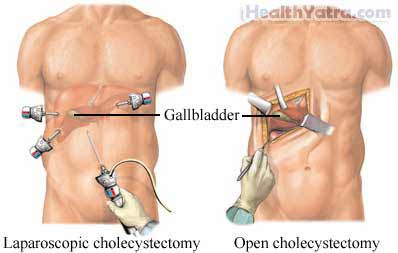Definition
Cholecystectomy is the surgical removal of the gallbladder. This procedure is most often done laparoscopically. This is done through several small incisions in the abdomen. In some cases, the doctor may switch to open surgery. This involves a large incision in the abdomen.

Reasons for Procedure
This surgery is used to remove a diseased or damaged gallbladder. The damage is often due to gallstones. Sometimes, gallstones get stuck in the gallbladder’s ducts. Bile, which helps with digestion, normally flows through these ducts. The blockage can damage the gallbladder and the liver.
Possible Complications
Complications are rare, but no procedure is completely free of risk. If you are planning to have a cholecystectomy, your doctor will review a list of possible complications, which may include:
- Gallstones that have accidentally spilled into the abdominal cavity
- Bleeding
- Infection
- Injury to other nearby structures or organs
- Reactions to general anesthesia
- Blood clots
Some factors that may increase the risk of complications include:
- Age: 60 or older
- Pregnancy
- Obesity
- Smoking
- Malnutrition
- Recent or chronic illness
- Diabetes
- Heart or lung problems
- Bleeding disorders
- Alcoholism and use of street drugs
- Use of certain medicines
What to Expect
Prior to Procedure
Your doctor will probably do some or all of the following:
- Blood tests to evaluate liver function
- Ultrasound to visualize gallstones
- HIDA scan—an x-ray test that uses a chemical injected into the gallbladder to create pictures the gallbladder and surrounding area
- EKG and chest x-ray —to make sure that the heart and lungs are healthy enough for surgery
- Other radiological scans
Leading up to your procedure:
- Talk to your doctor about your current medicines. Certain medicines may need to be stopped before the procedure, such as:
- Aspirin or other anti-inflammatory drugs for up to one week before surgery
- Blood-thinning drugs, such as warfarin (Coumadin)
- Clopidogrel (Plavix)
- Arrange for a ride to and from the procedure. Also, have someone help you at home.
- The night before, eat a light meal. Do not eat or drink anything after midnight.
- You may be given:
- Laxatives and/or an enema
- Antibiotics
- If instructed, shower before the procedure.
Anesthesia
General anesthesia will be used. You will be asleep for the procedure.
Description of Procedure
Four small openings will be made in your abdomen. Carbon dioxide will be pumped in to the abdomen to provide a better view.
The laparoscope will be inserted through one of the openings. It will provide images of the gallbladder and surrounding area. Instruments will be inserted through the small openings. They will be used to grasp the gallbladder and clip off the main artery and duct. The gallbladder will be removed through one of the small openings. Dye may be injected into the duct to look for stones. The entire abdomen will be carefully examined. The incisions will be closed with sutures or staples. They will be covered with bandages.
Your doctor may place a tiny, flexible tube into the area. This tube will exit from your abdomen into a little bulb. This is to drain fluid. The tube is usually removed within one week.
Immediately After Procedure
You will be taken to a recovery room.
How Long Will It Take?
About 30-60 minutes
How Much Will It Hurt?
You will have pain after the procedure. Your doctor will give you pain medicine.
Average Hospital Stay
If you do not have any problems, you may be able to go home the same day as the surgery or the next day.
Post-procedure Care
At the Hospital
After the procedure, the hospital staff will:
- Monitor you for any problems
- Give you medicines for nausea
- Provide you with nutrition through an IV (if you have a tube in your stomach to drain fluid)
- Help you to slowly progress from a liquid diet to soft foods
At Home
Recovery takes about three weeks. When you return home, do the following to help ensure a smooth recovery:
- Follow your doctor’s instructions.
- Also, follow the recommended diet and activity plan.
- Ask your doctor about when it is safe to shower, bathe, or soak in water.
Your liver will take over the functions of the gallbladder. You may notice that you have more trouble digesting fatty foods, especially during the first month of recovery.
Call Your Doctor
After you leave the hospital, contact your doctor if any of the following occurs:
- Signs of infection, including fever and chills
- Redness, swelling, increasing pain, excessive bleeding, or discharge at the incision site
- Cough, shortness of breath, chest pain
- Increased abdominal pain
- Pain that you cannot control with the medicines you have been given
- Blood in the stool
- Nausea and/or vomiting that you cannot control with the medicines you were given, or which last for more than two days
- Bloating and gas that persist for more than a month
- Pain, burning, urgency or frequency of urination, or blood in the urine
- Pain and/or swelling in your feet, calves, or legs
- Dark urine, light stools, or evidence of jaundice (yellowing of the skin or eyes)
In case of an emergency, call for medical help right away.
